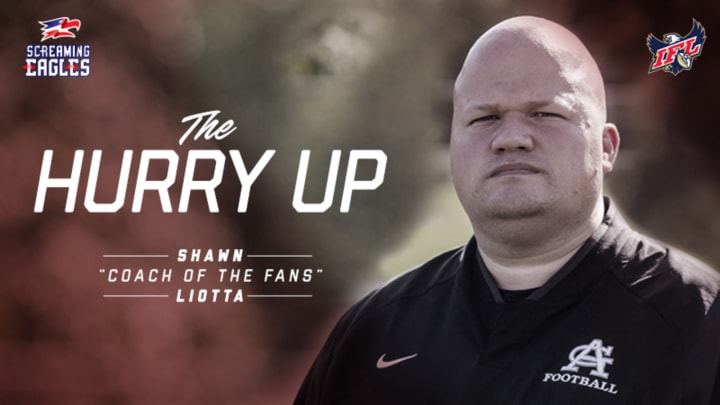How indoor football play-calling changes in the shadow of your own goalpost

“The Hurry Up” is Shawn "Coach of the Fans" Liotta's blog with information from his coaching experience, film study and conversations with industry leaders that may be pertinent to current trends and strategy in the Indoor Football League. Liotta is the coach of the fans of the Salt Lake Screaming Eagles, who rely on fan voting for everything—including play-calling.
This story was originally published on SaltLakeScreamingEagles.com.
It is extremely important for our fan play-callers to have an understanding of how field position can impact play-calling decisions and offensive design.
There are many variables that go into the implementation of a successful offensive attack. Through film study, coaches will create a plan that is reactive to variables that the play-caller will face during the game, such as hash, down and distance, and field position.
Today we'll look at calling the offense from the shadow of your own goal post, or what I refer to as the “Coming Off” field zone.
This area of the field is the five-yard space from the minus-five-yard-line to our own goal line. It can be a stressful area of the field for play-callers due to the fact that the offense is backed up and feeling the pressure to move the ball out of the area.
Let me take you through some of the thought process that I use while designing an offense in this area of the field and some ideas that may give you some food for thought while making play-calls in this area of the field.
1. Have a Sense of Urgency
The ball must come out of the quarterback's hand quickly and in rhythm. We want to avoid getting into scramble situations in this area of the field. Any offensive penalty in the end zone will result in a safety.
2. Expect pressure
Defenses will often attack offenses in this area of the field like a shark taking to blood in the water.
3. Quicks and Screens
Getting the ball immediately into the hands of one of your top playmakers in space along the wall can be a great way to get some breathing room.
4. Drive Starter
We have discussed the importance of “winning” on first down in previous blogs, and it is even more essential in this area of the field. It is important to have a “drive starter” on first down. It could be a run or quick pass to get the ball away from our own goal line and create a manageable down and distance situation later in the drive. We do not want to be facing fourth-and-10 from our own goal line.
5. Take a Shot
Don't be afraid to take a shot vertically down the field; it is one of the only opportunities where a quarterback and receiver can actually stretch the defense vertically down the field. This is also a great opportunity to run a “double move” or a “sucker go” off a screen play that you have set up earlier in the game.
6. Go for It on 4th Down from Your Own Goal Line
Sounds crazy, right? However, it's often the correct call.
As a fan play-caller on fourth down, you will have the option to select "go for it" or "kick a field goal". You may be tempted to select kick a field goal on fourth down to get the ball out of the end zone as a defacto punt to create field position.
Most Indoor Football League end zones are typically eight yards deep at the back wall. If you do the math with the field goal setup of seven yards from snap to hold, this gives the place kicker virtually no space or time to get off the kick. This can lead to a blocked kick recovered for a touchdown or a safety. So if the ball is on our own one-yard-line, roll the dice and let Coach Sauk dial up a play call.
Should the Screaming Eagles find themselves in a backed up situation, you will have a greater understanding of what to look for and the strategies that are often in play in this area of the field.
Feel free to ask Coach Liotta a question by emailing him at coachliotta@fanchi.se or tweeting him @ShawnLiotta.
